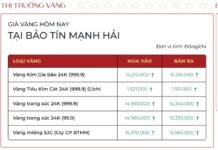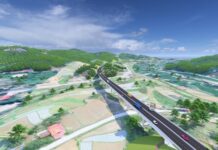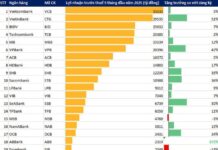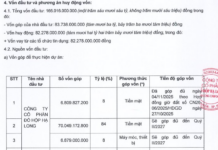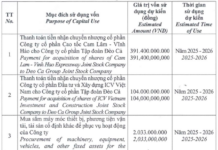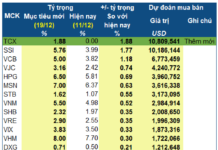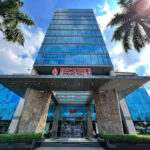Addressing Urban Development Needs in Southern Thai Binh City
The 2021-2030 plan, with a vision towards 2050, has presented Thai Binh province with a new growth challenge, particularly in terms of urban space expansion. As per the plan, Thai Binh City has been designated as a key urban center, aiming to become a green, modern, and unique city.
To meet these new development goals, there is a growing focus on expanding the city towards the south. This area holds potential to become a new central hub, alleviating future pressure on the city.
In terms of transportation infrastructure, the southern ring road of Thai Binh City is undergoing rapid development and is expected to be completed by October 2024. This project, along with National Highway 10, will enhance the city’s connectivity with southern districts and provide direct links to the Nam Dinh-Thai Binh-Hai Phong coastal road and the 30,583-hectare sea economic zone, all without having to pass through the city center.
This transportation network will facilitate Thai Binh’s connections to key economic regions, including Cat Bi Airport and Lach Huyen Port (Hai Phong), as well as Ha Long, Van Don, and Mong Cai (Quang Ninh). As a result, the movement of goods and people between Thai Binh and neighboring provinces, as well as exports, will become more convenient and efficient.
In terms of urban development planning, the southern part of the city is witnessing the formation of 10 large and small modern and integrated urban areas. Among them is a project by Daewoo E&C, a major developer, with a capital scale of nearly VND 10,000 billion.
Additionally, social infrastructure in the south is being prioritized, including the 10-hectare Ky Ba Park, which will be a landscape architectural highlight of Thai Binh City. The area will also boast a central hospital, a commercial center, entertainment venues, and other facilities, creating the foundation for a vibrant and bustling new urban core.
Leveraging these infrastructure advantages, the southern part of Thai Binh City is realizing its potential, becoming a rapidly developing urban area that attracts a strong residential community. The new planning space also demands that investors develop projects with harmony and modernity in mind, contributing to enhancing the quality of life and supporting the city’s goal of becoming a first-class provincial city by 2025. This is both a mission and a responsibility for urban developers.
Embarking on the Mission of Creating a New, Modern, and Integrated Urban Space
According to experts, real estate and urban development go hand in hand. Urban planning provides the foundation and impetus for new projects, and in turn, modern and integrated real estate developments contribute to enhancing the city’s appearance and living environment.
In the dynamic context of Thai Binh City’s southern expansion and population shift, Glory Downtown is a pioneering project that aligns with this vision. Strategically located at the central intersection of Le Quy Don, the project offers convenient access to the ring road and the city center, as well as the southern districts.
Glory Downtown is considered a vital link in the city’s development, contributing to the realization of a modern, unique, and integrated urban landscape in the south, in line with Thai Binh City’s overall growth trajectory.

Glory Downtown leads the way in the southern expansion of Thai Binh City.
As one of the pioneering urban areas in the south, the townhouses at Glory Downtown are built with a uniform exterior, designed in a modern and luxurious European style, giving the project a distinct character and a unique signature.
Glory Downtown (The Commercial Tourism and Commercial Housing Area in Tran Lam Ward, Thai Binh City) is also a pioneering project in the south, featuring three layers of interspersed parks and a seven-story commercial center, creating a harmonious space that ensures a green and healthy living environment for residents while attracting shoppers and boosting commercial potential for owners.
With a well-planned layout, 60% of the 128 shophouses have direct access to major roads, making them ideal for commercial and service industries such as finance and healthcare. The remaining 40% are adjacent to internal gardens, parks, and parking areas, making them suitable for restaurants, cafes, pharmacies, and wellness centers. This unique commercial advantage sets Glory Downtown apart in Thai Binh’s real estate market.
Its central location, long-term land auction legal status, and the southern area’s future development vision, make Glory Downtown a one-of-a-kind destination for both ideal living and safe, sustainable investment. This is why Glory Downtown has become a highly attractive project as Thai Binh’s real estate market enters a growth phase and attracts new investment waves.
Rearing in Revenue: The Ministry’s Mandate?
The Vietnamese government has made significant strides in reforming state capital investment management. One notable change is the decision to no longer manage second-tier enterprises and reduce the number of enterprises requiring the Prime Minister’s approval for leadership appointments. These moves signify a shift towards greater autonomy for businesses and a streamlined decision-making process. However, a point of contention remains: how should state-owned enterprises distribute profits when the state does not hold a substantial amount of capital in these businesses? This question sparks an important debate, highlighting the need to balance state involvement and enterprise independence.






